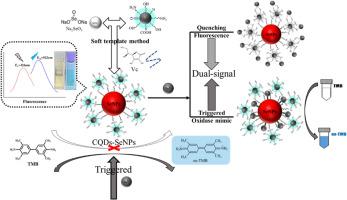利用碳量子点软模板制备多功能硒纳米酶的传感应用
IF 11.6
2区 材料科学
Q1 CHEMISTRY, PHYSICAL
引用次数: 0
摘要
本研究以碳量子点(CQDs)为功能模板,成功构建了具有双荧光和酶样活性响应特性的新型CQDs- senps稳定硒纳米酶。CQDs的稳定和功能化作用不仅实现了高度分散的SeNPs (DH为33.76±7.72 nm, Zeta电位为−45.67 mV),而且赋予其优异的光致发光性能和Hg2+触发的氧化酶样活性。通过荧光猝灭和酶活性激活的协同结合,建立了多模态Hg2+传感平台。该传感器具有选择性高、响应速度快(20 min)、荧光检测(0.78 ~ 12.50 μmol/L, LOD = 0.14 μmol/L)和比色检测(25.00 ~ 50.00 μmol/L, LOD = 6.13 μmol/L)双模式,检测范围为0.78 ~ 50.00 μmol/L。本研究的结果充分强调了CQDs在提高纳米材料性能方面的作用,并强调了硒基纳米酶在快速检测Hg2+方面的潜力。本文章由计算机程序翻译,如有差异,请以英文原文为准。

Soft-templated fabrication of multifunctional selenium nanozymes using carbon quantum dots for sensing applications
In this study, carbon quantum dots (CQDs) served as functional templates to successfully construct novel CQD-stabilized selenium nanozymes (CQDs-SeNPs) with dual fluorescence and enzyme-like activity response characteristics. The stabilization and functionalization effects of CQDs not only achieved highly dispersed SeNPs (with DH of 33.76 ± 7.72 nm and Zeta potential of −45.67 mV), but also endowed it with excellent photoluminescence properties and Hg2+-triggered oxidase-like activity. A multimodal Hg2+ sensing platform was developed by synergistically combining fluorescence quenching and enzyme activity activation. The sensor demonstrates high selectivity, rapid response (<20 min), and dual-mode detection: fluorescence (0.78–12.50 μmol/L, LOD = 0.14 μmol/L) and colorimetric (25.00–50.00 μmol/L, LOD = 6.13 μmol/L), achieving a broad detection range of 0.78–50.00 μmol/L. The results of this study fully underscore the role of CQDs in enhancing nanomaterial performance and highlight the potential of selenium-based nanozymes for rapid Hg2+ detection.
求助全文
通过发布文献求助,成功后即可免费获取论文全文。
去求助
来源期刊

Carbon
工程技术-材料科学:综合
CiteScore
20.80
自引率
7.30%
发文量
0
审稿时长
23 days
期刊介绍:
The journal Carbon is an international multidisciplinary forum for communicating scientific advances in the field of carbon materials. It reports new findings related to the formation, structure, properties, behaviors, and technological applications of carbons. Carbons are a broad class of ordered or disordered solid phases composed primarily of elemental carbon, including but not limited to carbon black, carbon fibers and filaments, carbon nanotubes, diamond and diamond-like carbon, fullerenes, glassy carbon, graphite, graphene, graphene-oxide, porous carbons, pyrolytic carbon, and other sp2 and non-sp2 hybridized carbon systems. Carbon is the companion title to the open access journal Carbon Trends. Relevant application areas for carbon materials include biology and medicine, catalysis, electronic, optoelectronic, spintronic, high-frequency, and photonic devices, energy storage and conversion systems, environmental applications and water treatment, smart materials and systems, and structural and thermal applications.
 求助内容:
求助内容: 应助结果提醒方式:
应助结果提醒方式:


